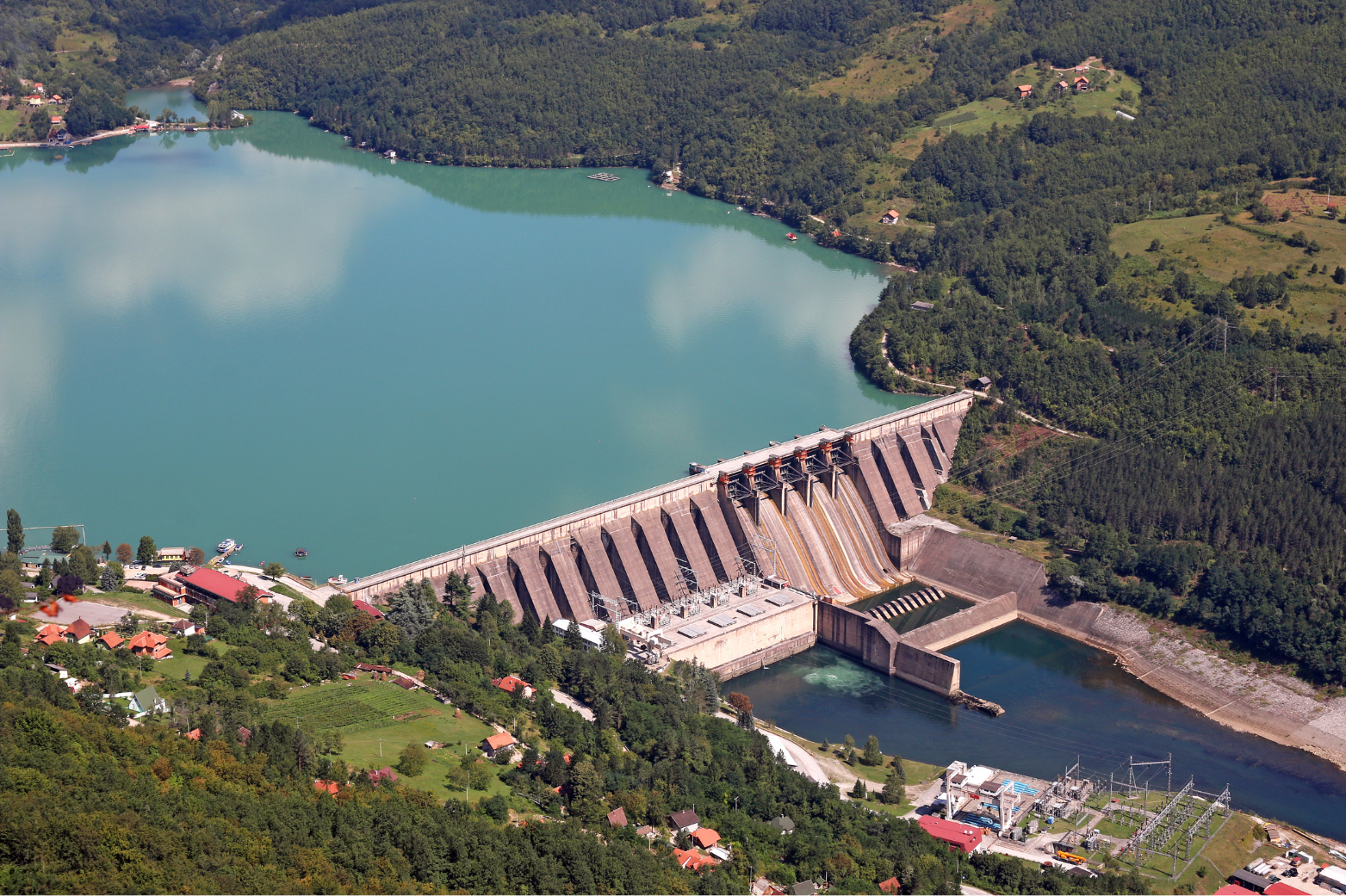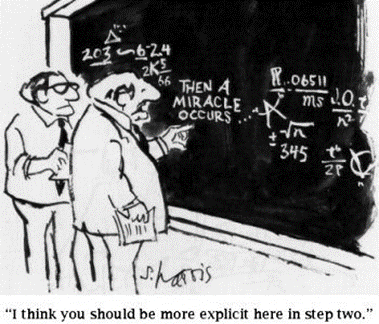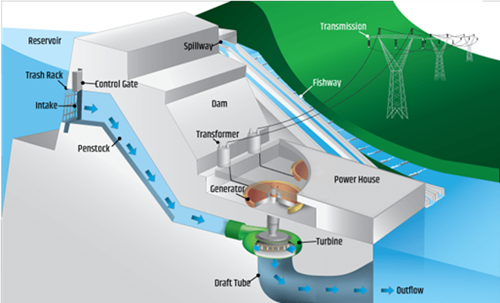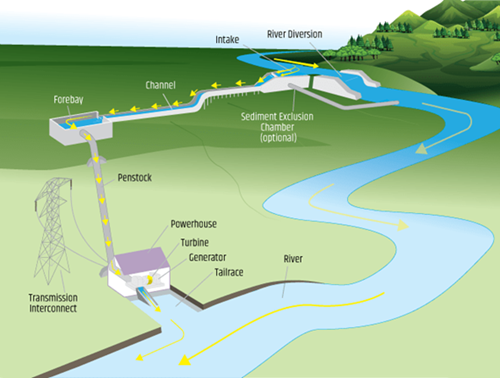
ABSTRACT
Hydro is the world’s largest, most reliable, most flexible, and cheapest source of clean and renewable energy. In 2021, it provided 6.3% of all primary energy, about half as much again as wind and solar combined. It generated 16% of global electricity production, third highest after coal and natural gas. Pumped storage plants comprised 90% of the world’s total energy storage capacity. Hydro is not dependent on the weather, the season, or the time of day. It can be ramped up or down at any time to meet daily, seasonal, and random changes in demand. When all costs including system costs over the whole production/life cycle are considered, hydro is cheaper than intermittent renewables. A thriving hydropower industry must be an important part of any realistic plan to reach Net Zero by 2050.
INTRODUCTION
In its Net Zero by 2050 report, the International Energy Agency (IEA) adopted the plausible assumptions that global population will rise by about 2 billion and gross world product (GWP) will more than double during 2021-50. These assumptions imply that per capita income will increase by at least 60% over the three decades. IEA also accepted that per capita income would grow faster in the developing economies, where income elasticities of demand are much higher. However, its net zero pathway requires that the global demand for energy over the 30-year period decline by 8%. This is to be achieved by “a singular, unwavering focus from all governments” on adopting a raft of new policies that will lead to “More efficient use of energy, resource efficiency, and behavioural change” (IEA, 2022).

Even if the demand requirement for net zero (emissions) by 2050 were to be met, there would still be a risk to the global community, especially its most poor, from IEA’s aggressive approach toward fossil fuels (IEA seeks “a huge decline in the use of fossil fuels”), luke-warm support for hydro and nuclear (currently the two largest suppliers of clean energy), and reliance on wind and solar to ensure supply meets demand. The risk would be that the projected 20-fold increase in solar PV capacity and 11-fold increase in wind capacity does not occur.
However, the greater risk lies in the demand requirement – that the global demand for energy falls by 8% over the three decades to 2050. The US Energy Information Administration (EIA) projects that, with current policies, global energy demand will rise by 47% during this period, with most of the increase being in the developing countries, especially in Asia. Modelling by UBSS CSR produces a similar result.
If the huge policy shift required to contain global demand under the IEA scenario does not materialise, but the policy recommendation that there be no new investments in fossil fuels is implemented, the world may be faced with a potentially huge shortfall in energy supply. Sources of energy other than fossil fuels (where new investment is stopped under the IEA scenario) and intermittent renewables (which are growing at maximum capacity) will need to be exploited to reduce the shortfall. It is therefore useful to explore these other sources. Nuclear, as indicated in an earlier article (Hooke, 2022) is a very promising additional resource. The present article considers the advantages and disadvantages of hydro and whether, like nuclear, it can make a meaningful contribution to filling the gap that could emerge from selective adoption of IEA policy recommendations.
HOW HYDRO WORKS
About 75% of the Earth’s surface is covered by water: 63% by oceans and seas, 1% by liquid freshwater such as lakes and rivers, and 11% by ice. Liquid freshwater is currently the source of almost of the world’s hydropower. In the future, water in the oceans and seas – the largest collectors of solar energy on the planet - might also become an important source.

Existing hydropower plants harness the kinetic energy contained in flowing water to produce electricity or direct power. The water flow can be natural, in the form of streams, rivers, or waterfalls, or it can be altered by introducing a barrier such as a dam. There are two main types of net-energy generating hydropower facilities: impoundment and diversion. Impoundment facilities, though less numerous, are the more important source of hydroelectricity. They typically have three parts: a reservoir, a dam (wall), and a power plant. The reservoir stores the water. The dam keeps the water in the reservoir, but also has gates that allow a controlled flow of water through passages linking the reservoir to the power plant. The water powers turbines that spin generators to produce electricity that is then fed through transmission and distribution lines to end users (Nunez, 2022).

Diversion, or “run-of-river”, facilities use the natural decline of river beds to produce energy. They typically contain a channel through which a segment of the river is diverted. The channel has a more gradual slope than the natural river bed. The longer is the channel and the steeper is the terrain the greater is the difference in elevation between the water in the channel and that in the river. When the difference is sufficiently great, the channel ends and the water is stored in a forebay above the electricity-generating plant. The water flows from the forebay through the turbines to start the energy-generating process and is then returned to the natural river bed. The big advantage of diversion facilities is that they pose far fewer environmental or social concerns than do large, dam-based projects.
Water can also be used to store energy produced from other sources such as intermittent wind and solar. Pumped storage hydropower (PSH) plants serve as giant batteries, saving energy when it is not needed and releasing it when there is a need. When there is an excess supply of energy because demand is low (e.g., during the daytime in Spring or Autumn) and/or supply is high (e.g., because the winds are blowing strongly or the sun is shining brightly), the PSH facility uses the excess supply to pump water from a lower reservoir to a higher reservoir. Then, when the excess supply is replaced by excess demand (e.g., during the evening - especially in mid-winter - or when the winds have abated or the sun has dimmed), the water in the upper reservoir is released through the turbines to generate electricity. The power generated when the water is released from the upper reservoir is less than that needed to pump the water into the reservoir, so PSH plants are not net generators of energy. However, their ability to match supply at the turbines in line with demand by users makes them a valuable companion to intermittent energy sources.
Oceans produce two kinds of energy: thermal and mechanical. The sun’s heat warms surface water more than it does deeper water, and this difference in temperature creates thermal energy. Mechanical energy is provided by tides (driven primarily by the gravitational pull of the moon) and waves (driven mainly by winds). Technologies for generating energy from the ocean are still in the early stages of commercialisation and currently have only niche applications such as powering oil and gas platforms, marine farms, naval bases, and luxury residential or tourist resorts. However, they could become important in the next few decades. According to IEA, energy generation from oceans must achieve an average annual growth rate (AAGR) of 33% during the coming decades if the goal of net zero emissions by 2050 is to be achieved (Masterson, 2022).
HISTORY
The earliest recorded use of water as a source of direct power dates back to the first millennia BCE, when water mills were built by the Greeks to grind wheat into flour and by the Romans to cut logs into timber and stone into building blocks. In China, during the rule of the Han Dynasty (206 BCE – 9 CE), hydraulically operated pumps fed water into canals where it was used for irrigating crops, and vertical water wheels were used to power trip hammers that pounded and hulled grain and broke rocks to release ore (Roome, 2016).

More recently, hydro has been credited with triggering the industrial revolution. In 1771, when Sir Richard Arkwright set up Cromford Mills in Derbyshire, England to spin cotton, he added a major innovation: he organised production around a factory-focused, rather than a household-based, system. To power his mill, he used the flowing water of a small tributary to the Derwent River. Over the following two decades, hundreds of similar factory systems of cotton production using water power were set up throughout England, ushering in a 200-year era in which industry rather than farming became the major source of the country’s - and soon the world’s - economic growth (Hooke, 2019).
Hydro technology advanced rapidly in the 19th century. In 1827 Benoit Fourneyron, a French engineer, won a prize of 6,000 francs for developing a water turbine engine capable of generating 6 horsepower (4.5 Kw) of energy. Fourneyron continued to work on his engine and by 1837 had increased its energy output to 60 horsepower (45 Kw). In 1849 James Francis, a British-American engineer, developed the Francis turbine, which is still the most popular water turbine globally. By the end of the century, numerous small hydropower plants were operating in many countries around the world. Nevertheless, global production of hydropower in 1900, of 47 terawatt hours (TWh), was only 0.04% of total primary energy production.
In the 20th century, the development of hydropower capacity and production “evolved from a trickle in the early decades, to a steady stream in the decades following the Second World War, and finally to a roaring stream in the three dam decades of the sixties, seventies, and eighties.” (Asmal, 2022). Prior to the 1980s, large dam-based hydro plants were a source of considerable national pride in most regions and countries - a symbol of economic development and a promise of future prosperity. During the first half of the 1970s, an average of three large dams were built per day. New projects were initially concentrated in the high-income countries, but from the early 1980s focus increasingly was on China, India, and other developing countries, where funding by the World Bank and other aid organisations was significant. Critics of these supranational institutions and of big foreign corporations generally mounted increasingly effective campaigns against the perceived lack of sufficient attention to the adverse effects the projects were having on the local environment and on traditional societies. In the 1980s and, especially, the 1990s dams became the “most contested and spurned forms of development intervention worldwide” (Asmal, 2022). Well-organised activism led to projects being subjected to long delays and rapidly rising costs. The number of large dams under construction fell from a peak of more than 5,400 in the 1970s to less than 2,100 in the 1990s.
Increasing publicity of the contribution dams make to town and city water supplies, to irrigation and hence food production, to flood mitigation, and to energy supplies on the one hand, and the need to avoid, mitigate, or compensate for adverse environmental and social effects of dam construction on the other, led to the establishment of a World Commission on Dams (WCD) in 1998. The Commission was charged with reviewing global evidence on the benefits and costs of large dams and making recommendations on best practices during their planning construction, operation, and decommissioning phases. The Commission’s report, which was released in 2000, received a mixed reception from stakeholders. However, it did produce a wider understanding of the benefits of dams among critics and of the need to better address environmental and social costs among developers. It led to parts of the dam construction industry and their business partners proposing, in 2010, best practice guidelines in the form of a Hydropower Sustainability Assessment Protocol (HSAP), a multi-stakeholder tool for assessing projects at all phases of the lifecycle.
Early in the 21st century, hydropower regained its earlier momentum. During 2000-17, installed capacity rose by 65%. Growth was driven by several factors including: (1) greater attention to mitigating adverse environmental and social impacts in new hydro plant proposals and consequently less opposition to these proposals; (2) wider recognition of the role that hydropower, especially small hydropower plants (capacity less than 20 MW), can play with regard to internationally agreed development and environmental goals; (3) increased funding from the World Bank and from financial institutions in developing countries such as China, Brazil, and Thailand; and (4) strong growth in the demand for energy in developing countries, especially Brazil and China where potential for using hydro is relatively large. In China, installed capacity more than quadrupled and accounted for more than half of global hydropower capacity growth during 2000-17.
THE ADVANTAGES OF HYDRO
Hydro has many advantages: a single plant can meet the energy needs of millions of people; hydro-electricity is cheap; it is much more reliable than wind and solar; it is flexible; it can store a large amount of electricity; and there is still considerable scope for expanding its capacity.
Hydro plants have the largest scale range of any energy source. They can be very big. Of the 20 largest power plants in the world, 12 are hydro (six of the remainder are nuclear, one is natural gas, and one is wind). The biggest power plant in the world, the Three Gorges Powerplant in China, can produce enough energy in one day to meet the power needs of 5.4 million Chinese households for a month. In 2020, the energy generated by the plant supported 10% of China’s GDP (China Daily, 2021). Hydro plants can also be very small, servicing small villages and even single households.
Hydro power is the cheapest source of renewable energy. According to IRENA (2022), the global weighted-average cost of electricity from newly commissioned projects in 2019 was $0.047 per kilowatt-hour (kWh) for hydro, $0.053 per kWh for onshore wind, $.068 per kWh for solar PV, and $0.115 per kWh for offshore wind. Since these figures do not include system costs, which are very high for solar and onshore wind and very low for hydro, the full cost advantage of hydro is much greater than these partial figures suggest.
Impounded hydro is the most reliable source of clean energy. Unlike wind and solar, it is not dependent on weather, time of day, or season. Hence, it does not require backup supplies when the wind is not blowing and/or the sun is not shining. Many run-of-river facilities are located on rivers where water-flow is reliable – and much more reliable than the shining of the sun or the blowing of the wind.
Hydro is the most flexible energy source. Modern plants can be started and stopped relatively smoothly and can ramp their electricity generation up or down very quickly. This enables them to adjust rapidly to regular or unexpected changes in demand and to compensate for fluctuations in supply from other sources of power such as wind and solar.
Hydro is the largest holder of stored energy. Existing reservoirs can store 1,500 TWh of electrical energy. This is almost 2, 200 times larger than all battery capacity, including that in electric vehicles.
There is still considerable scope for increasing hydro-energy capacity. Most of the world’s hydroelectricity comes for impoundment plants. These require reservoirs, which can only be built in specific locations - where water is abundant and topography is favourable for dam construction. In the high-income countries, “the best places for hydro are already taken” (Energy Monitor, 2020). However, the US Department of Energy believes that even in the United States there is still considerable potential for growth by upgrading old plants and adding electricity-generating plants to existing reservoirs currently used only for other purposes. Malcolm Woolf, President of the US National Hydropower Association, noted that the United States has about 90,000 dams, most of which were built for water storage, irrigation, flood control, or recreation. Less than 3% of these dams are used to generate electricity. Scope for growth is greater still in developing countries, where about 60% of suitable locations have yet to be developed.
THE DISADVANTAGES OF HYDRO
Hydro’s disadvantages include vulnerability to drought; risks to safety from dam failure; the legacy of poorly designed hydro projects on the environment and local societies; and the limitations on its ultimate capacity to provide energy.
While hydro is a more reliable source of electricity than onshore wind and solar, it is still vulnerable to irregular droughts and long-term changes in rainfall patterns. According to IEA (2022), recent droughts in the American west have reduced the capacity of the region’s dams by about 20%. In September 2022, electricity generation at the Three Gorges plant was reduced by 30% due to a drought-induced decline in water supply from the Yangtze River. (Nuclear is the only source of clean energy that has virtually zero reliability problems).
Dam failures are not uncommon – according to Wikipedia, there have been 47 failures this century, including 13 in the United States and five in Europe. Virtually all of the recent failures have been associated with very old dams. The risk of catastrophic failure is probably negligible for newly-built dams in high-income countries but can still be significant in some developing countries. When a 1-in-10,000-year flood caused the Bianqiao Dam in China’s Henan province to burst in 1975, all 9,600 citizens of the town of Daowencheng, which was located just below the dam, were immediately submerged and killed. A further 61 dams collapsed downstream, where an additional 220,000 people lost their lives. The disaster occurred during China’s cultural revolution and details were concealed until the 1990s. The US Discovery Channel later rated the Bianqiao Dam failure the No.1 in "The Ultimate 10 Technological Disasters" of the world.
Most of the global hydroelectricity supply and all of the hydroelectricity storage comes from impoundment plants. Eventually, if demand for hydroelectricity remains strong, all feasible sites may be exploited. If so, growth through new plants will cease. However, this will not be a constraint during the period up to 2050. In fact, it probably never will be. With global population growth declining, per capita incomes increasing strongly in most countries, and the income elasticity of demand being negligible at high levels of per capita income, the growth of global demand for energy can be expected to fall significantly in the latter half of the century. At the same time, increases in the capacity of other energy sources and development of new energy sources such as nuclear fission should see the growth of potential supply moving increasingly ahead of the growth of demand. Energy supply is likely to be a short-term and medium-term, not a very long-term, problem.
Hydro, along with wind, solar, and nuclear, is regarded as a clean energy source because the actual generation of electricity in the power plant does not produce emissions. However, as with the other so-called clean energy sources, emissions are generated in producing, assembling, and transporting the materials and machinery used in construction of the energy-generating plant. In addition, hydropower emissions can come from clearing forests to make way for dams and from the fermentation of inundated vegetation in reservoirs. These problems tend to be most severe in tropical areas and in the short term. According to Mark Mulligan, a hydro specialist at Kings College London, “the methane problem from hydro does not compare overall with equivalent emissions from coal, oil, or gas. But it is an indicator that there is no free card in electricity generation – everything has an impact” (Energy Monitor, 2022).
THE FUTURE OF HYDROPOWER
IEA (2021) expects that global hydro global capacity will increase by 17% during 2021-30. This will come 50% from reservoir plants and 20% from run-of-river plants. The remining 30% will be from pumped-storage plants. Growth will be driven by the need to provide system reliability and flexibility while accommodating a growing share of intermittent renewables. Very little growth is expected in Europe and the United States due partly to “the onerous licensing and permitting process” (CNBC, 2022). However, net additions to capacity will continue to be significant in Asia Pacific, Africa, and the Middle East. The largest increases in capacity will be in China (40% of the global expansion) and India.
However, net additions to capacity in the 2020s will still be 25% lower than in 2010s. Barriers to the growth of hydropower include lengthy permitting processes, expensive environmental assessments, and opposition from local communities. However, according to Fatih Birol, Executive Director of IEA, “Hydropower needs to be put squarely back on the energy and climate agenda if countries are serious about meeting their net zero goals”. IEA estimates that removing unnecessary barriers, thereby unblocking projects already in the pipeline, would result in a rise in new capacity generation of about 40% during the 2020s.
CONCLUSIONS
Hydropower is the world’s fourth largest source of energy (after oil, coal, and gas) and the largest source of clean energy. It will need to maintain its role as a major supplier if the future demand for energy is to be met, and if the world is to transition to, or near to, net zero emissions by 2050.
In most high-income countries, the replacement of existing plants and the commissioning of new plants is impeded by regulatory requirements that are more onerous even than those for fossil fuels and nuclear. Governments should place priority on adopting a more positive approach to simplifying approval processes, both for new plants and for plants where existing licences are approaching expiration dates. For its part, the hydropower industry will need to focus on adherence to HSAP guidelines and adoption of best practices so as to increase social acceptance of hydropower projects.
REFERENCES
Asmal, K. (2022). Introduction: World Commission on Dams Report, Dams and Development. The American International Law Review. https://digitalcommons.wcl.american.edu/auilr/?utm_source=digitalcommons.wcl.american.edu%2Fauilr%2Fvol16%2Fiss6%2F1&utm_medium=PDF&utm_campaign=PDFCoverPagesBirol, F. (2021).
China Daily (2021). Three Gorges Dam sets power generation record in 2020. 02.01.2021.
http://www.china.org.cn/business/2021-01/02/content_77072855.htm.
Hooke, A. (2019). Global Economic Development. Lakeland House.
Hooke, A. (2022). Primary energy markets – Nuclear. Post-COVID Reflections on Unit Content and Delivery, Assessment, and Student Engagement. Intertype.
IEA. The World Energy Outlook, 2021. https://www.iea.org/reports/world-energy-outlook-2021.
IEA Press Release (2021). Hydropower has a crucial role in accelerating clean energy transitions to achieve countries’ climate ambitions securely.
https://www.iea.org/news/hydropower-has-a-crucial-role-in-accelerating-clean-energy-transitions-to-achieve-countries-climate-ambitions-securely.
IEA (2021). Hydropower is the forgotten giant of low-carbon electricity.
https://www.iea.org/reports/hydropower-special-market-report/executive-summary
Masterson, V. (2022). Wave energy: can ocean power solve the global energy crisis?
https://www.weforum.org/agenda/2022/03/wave-energy-ocean-electricity-renewables.
Roome, J. (2016). Hydropower in Vietnam: The right way to do it.
https://blogs.worldbank.org/climatechange/hydropower-vietnam-right-way-do-it
Rosenberg, L. (2022). Hydropower at China’s Largest Plant, Three Gorges Dam, Stunted by Ongoing Drought.
https://www.greenmatters.com/renewables/three-gorges-dam-drought.
Timperley, J. (2020). Can hydropower be part of a clean energy future?
https://www.energymonitor.ai/sectors/power/can-hydropower-be-part-of-a-clean-energy-future.
Wikipedia (2022). List of major dam failures (2022). https://en.wikipedia.org/wiki/Dam_failure#List_of_major_dam_failures.
Zubrin, R. (2022). How we can get clean energy-What needs to be done? Quillette. https://quillette.com/2022/05/17/how-we-can-get-clean-energy-what-needs-to-be-done.
BIOGRAPHY

Angus Hooke is Emeritus Professor, Senior Scholarship Fellow, and Director of the Centre for Scholarship and Research (CSR) at UBSS. His earlier positions include Division Chief in the IMF, Chief Economist the NSW Treasury, and Professor and Head of the Business School (3,300 students) at the University of Nottingham, Ningbo, China. Since early 2019, Angus has published 15 refereed articles, authored one book on Economics, and been Chief Editor of seven books (four with Professor Greg Whateley, all for the UBSS CSR).




